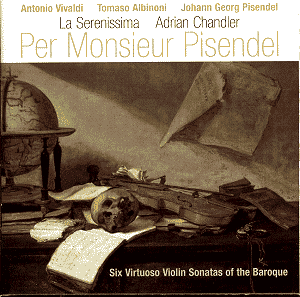Every period has its stars, and the 18th century was
no exception. The German violinist Johann Georg Pisendel was the star
of his time. He was an exceptional talent, and was recognized as such
by the likes of Johann Sebastian Bach, Antonio Vivaldi and Tomaso Albinoni.
He was a member of the Dresden court orchestra, which was considered
the best ensemble of Europe, and which consisted of many virtuosos on
their instruments, like the flautist Buffardin and the double bass-player
Zelenka.
That Pisendel appears mentioned on a CD with Vivaldi
and Albinoni is no coincidence. Pisendel went to Venice to study with
Vivaldi. It seems that the ‘red priest’ treated him more like a colleague
than a pupil. He showed his admiration by dedicating a number of sonatas
to him. Many Vivaldi compositions by have been found in Dresden, which
most likely is the direct result of his close relationship with Pisendel.
It was in Venice that Pisendel must have met Tomaso
Albinoni as well. He was just as impressed as Vivaldi, which resulted
in at least one sonata specifically dedicated to Pisendel. The other
sonata recorded here was also found in Dresden, but without the name
of the composer. In 1976, the handwriting was identified as Albinoni’s,
so it is safe to assume that this sonata is another which Albinoni composed
for Pisendel.
And, like many musicians in the baroque era, Pisendel
also composed for his instrument. Two of his own sonatas are recorded
here. The sonata in D is a mixture of German and Italian styles. The
first movement links up with the German ‘stylus phantasticus’ of the
17th century, with its quick alternation of motifs.
Sample 1 Track 1 0:00
The last movement demonstrates Vivaldi’s influence,
especially in frequent double-stops toward the end.
As far as the programme on this CD is concerned: this
is a very admirable effort to present a forgotten master in his proper
context. But some decisions taken here are questionable.
It is possible that Pisendel played the sonatas Vivaldi
and Albinoni composed for him when he stayed in Venice. But in the booklet
nothing is said about the date of Pisendel's own works. It is reasonable
to assume that he composed them in Dresden. And since almost all of
the sonatas dedicated to him have been found in Dresden it is very likely
that he took them with him when he returned to Dresden and played them
there. Pitch there was certainly not higher than a=415’. From that perspective
it is a little strange that all works are played here at the Venetian
standard pitch a=440’. And although it is not impossible, it is rather
unlikely that at the Dresden court an Italian harpsichord would have
been used for the basso continuo – as is the case here.
Pisendel's Sonata in E minor exists in two versions.
The musicians have decided to perform the latter one, but also to include
the 'arioso' from the first version, which Pisendel later removed. I
can understand that they wanted to record it, but it would have been
far better to keep it separate from the rest of the sonata. What we
have here is a mixture of two versions, which in fact never existed.
I am not very enthusiastic about the way these sonatas
are played. The interpretation is very mechanical: the musicians choose
a tempo and stick to it very strictly, without any variation. And since
the violinist plays legato almost constantly, this results in a rather
undifferentiated performance. Basically everything is played the same
way, whether the sonata is in major or minor. The tempi are not always
well chosen. The tempo in the 'moderato' movement of Pisendel's Sonata
in e minor is too fast.
Sample 2 Track 17 1:00
And 'grave' is perhaps the slowest movement in the
baroque period, but the musicians seem not to know (Vivaldi, Sonata
in c minor).
The use of ornamentation is very inconsistent. Sometimes
phrases are repeated without any ornamentation at all, which is anything
but ‘authentic’.
The performance of Pisendel's Sonata in D is simply
unacceptable. The rhetorical gestures in this work are completely ignored,
the contrasts are smoothed down and there is a total lack of agogics
here. Not that the Italian sonatas are much better. In the largo of
his Sonata in C (RV 2) Vivaldi frequently uses the rhetorical figure
of the ‘suspiratio’, but here that goes by unnoticed.
Sample 3 Track 22 1:45
As interesting as the programme on this CD is, and
as positive as the attention given to Pisendel, the musicians haven't
done the music justice. The playing is virtuosic, but superficial.
Johan van Veen

